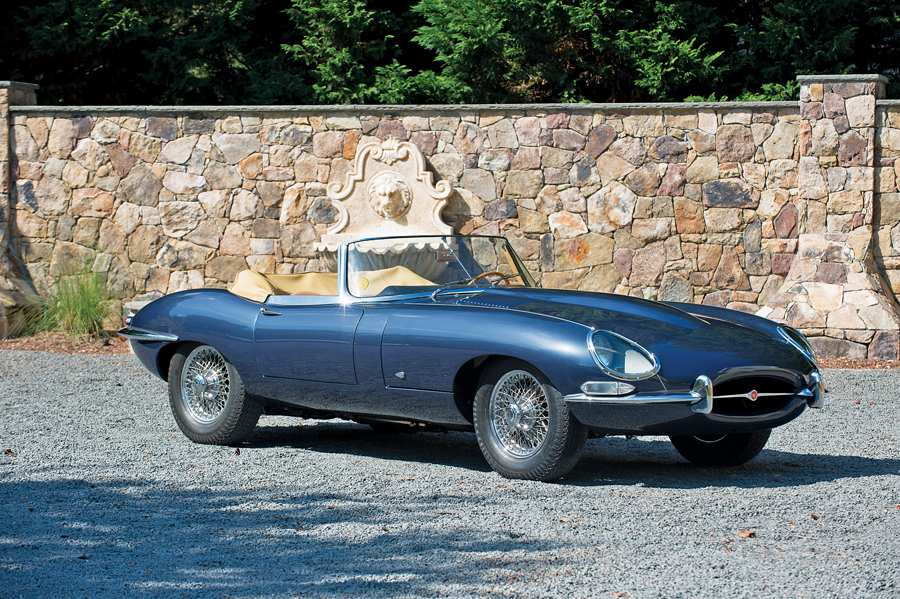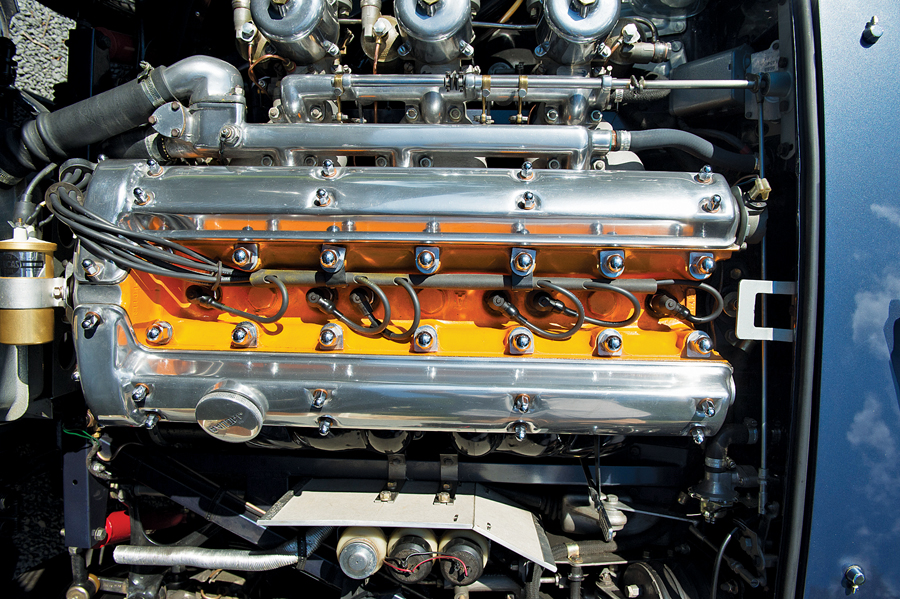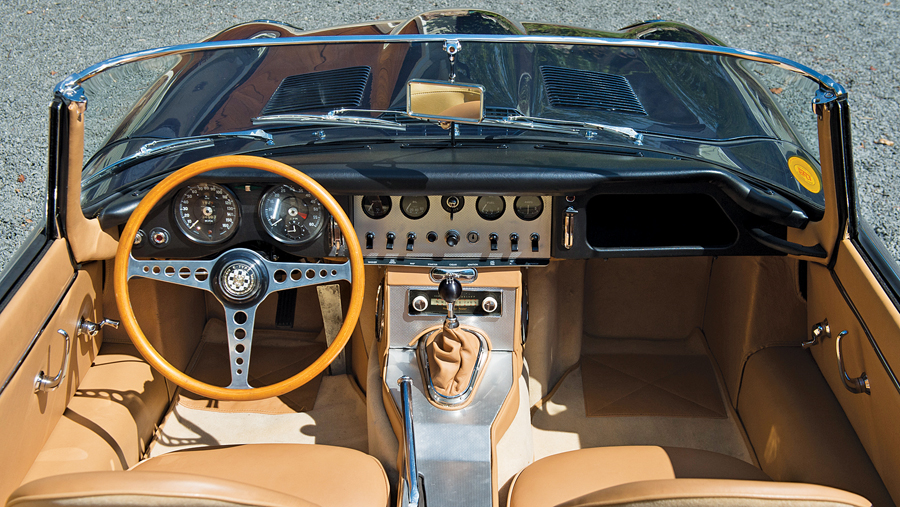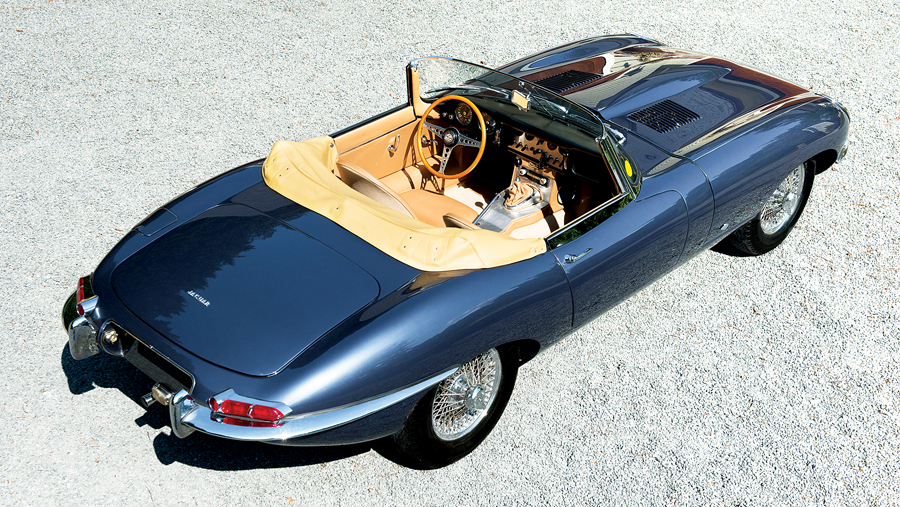SCM Analysis
Detailing
| Vehicle: | 1961 Jaguar E-Type Series I |
| Years Produced: | 1961–64 (Series I 3.8-liter) |
| Number Produced: | 6,886 Series I 3.8-liter LHD roadsters (15,498 Series I 3.8-liters total) |
| Original List Price: | $5,670 (as tested by Car and Driver in 1961) |
| SCM Valuation: | $215,000 |
| Tune Up Cost: | $250–$500 |
| Chassis Number Location: | Plate on top of right footwell box under bonnet, and on frame at top of front suspension mount |
| Engine Number Location: | Right side of engine block atop oil-filter mounting flange under Jaguar logo |
| Club Info: | Jaguar Club of North America |
| Website: | http://www.jcna.com |
| Alternatives: | 1958–62 Aston Martin DB4, 1958 Porsche 356A Speedster or 356 Roadster, 1957–61 Mercedes-Benz 300SL Roadster |
| Investment Grade: | B |
This car, Lot 125, sold for $326,700, including buyer’s premium, at Bonhams’ Amelia Island sale on March 9, 2017.
You’d be hard pressed to find a collector car auction these days that didn’t include an E-type roadster. And, usually, each auction house has a number of examples on offer — many sold without reserve.
E-types are among the most frequently offered collector cars for consignment to an auction house — and for good reason. There is usually no shortage of E-types on the market, and often the prices achieved at auction are in excess of the concurrent average asking price elsewhere.
The E-type is perhaps the most fashionable collector car of all time; it is known the world over. Its iconic status and influence has been covered in print for decades, and you’ve probably noticed that the E-type is the backdrop for countless style and luxury advertisements. Quite obviously, the popularity of the model improves the chances of a result exceeding market expectations.
We also see this with Mercedes 280SLs. The market’s strength is derived from its breadth. That pool of potential buyers is made up of established collectors, newcomers and everyone in between. And that is a powerful factor in an auction room.
Early versions are prized
Within this broad E-type market, some buyers (and sellers) look to differentiate among the numerous offerings. Between 1961 and 1964 a total of 6,886 Series I 3.8-liter roadsters were built in left-hand-drive configuration (and that’s just a portion of total E-type production). The cars are by no means scarce.
The outcome of this desired differentiation is the increased collectibility — and value — of the earliest iterations, which feature the “flat-floor, welded-louver, outside-bonnet-latch” specification. But differences are really pretty nominal. Do we really think a little extra hardware warrants a six-figure premium?
I’ll admit that I’ve never agreed with the emphatic valuations of “first of this” or “last production that….” I personally feel there are far more important characteristics or qualities that determine the value of a car — not just its unique order in a production sequence.
I find that all too often an inherently good car is overlooked because it lacks a certain “buzzword” quality. Take the “rack-and-pinion” versus “worm-and-sector” Cobra 289s, or “torque-tube” Ferrari 275s. Unlike the “flat-floor, welded-louver, outside-bonnet-latch” criteria, those specifications do have an effect on the driving characteristics of the car. But even these buzzword guidelines can lead buyers astray.
In large part, I don’t disagree with the differentiation or classification of particular examples to better understand their place in the market, but you do so at the risk of losing an understanding of how to evaluate an individual example.
Dueling E-type Series I cars at Amelia
At Amelia Island, a total of eight Series I E-type roadsters were available between the Bonhams, Gooding & Company and RM Sotheby’s sales. The prices ranged from $94,600 to $412,500.
Looking at our subject E-type, the car possessed all of the desired early-production features, but the car strayed from its as-delivered specification. As noted in the catalog, the E-type received some mechanical upgrades, all of which were said to be easily reversible, including a 5-speed gearbox, and furthermore, was finished in an appropriate — but non-original — color scheme.
The car sold for $326,700 — a figure that warrants a “well sold” for an E-type roadster, but likely not for a “flat-floor, welded-louver, outside-bonnet-latch” example.
By comparison, just two days later, RM Sotheby’s sold another early-production E-type for $412,500. In addition to all of the desirable early features — as also seen on our subject vehicle — the RM Sotheby’s car also boasted a well-documented restoration, a high level of presentation and was also offered without reserve. This car, however, was finished in its original color scheme, and as far as I know, was entirely in as-delivered configuration.
The first early E-type to catch our attention was a right-hand-drive example that Bonhams sold in September of 2013 on behalf of the original owner. And at the time it brought $281,354, a remarkable result for a right-hand-drive E-type. Nearly a year later, Gooding sold another particularly early example, highly restored, for an earth-shattering $528,000. Since late 2013, we’ve seen early-production, left-hand-drive examples (with the three key features) bring an average price of $366,000.
Close, but not quite
So our subject vehicle sold below market expectations — and the printed estimate of $350,000 to $425,000. Why? Frankly, I think it was too easy to discredit the car given the color change and modifications, particularly when another, similar example is on the market.
In the grand scheme of things, I’ve never felt that a color change should have a huge effect on the value of a Jaguar so long as the color was period-appropriate. But what I see in this specific result is that when you ask the market to reach for a car that is being differentiated as a more desirable and collectible variant, you’re undermining the offering with the lack of originality. In 2017, buyers are looking for reasons not to pay too much, and in this case, I think they found one.
In looking at the results for the eight E-types on offer among Amelia Island’s three major auction houses, the market showed that people will pay much more, sometimes even multiples, for the best available example.
And to me that makes sense. As I’ve written before, the pricing spread between good, better and best should — and will — continue to grow.
I think there is still plenty of value in E-types. But in the $250,000-plus range, I would need to be seriously impressed to agree it’s money well spent. ♦
(Introductory description courtesy of Bonhams.)



